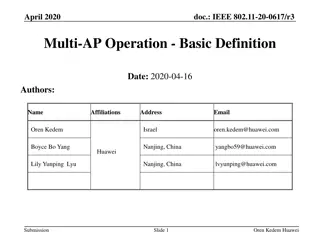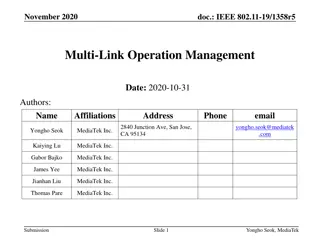Multi-BSSID Operation with MLO Overview and Signaling Considerations
The document discusses the integration of Multiple BSSID set feature and Multi-Link Operation (MLO) in IEEE 802.11 networks. It delves into the setup of virtual Access Points (APs) on the same device with distinct attributes, the formation of common parameters across APs within an MLD, and the signaling mechanisms for conveying information about virtual APs and MLD attributes through beacons. The concept of multiple MLDs for a set of links is also explored in detail.
Download Presentation

Please find below an Image/Link to download the presentation.
The content on the website is provided AS IS for your information and personal use only. It may not be sold, licensed, or shared on other websites without obtaining consent from the author.If you encounter any issues during the download, it is possible that the publisher has removed the file from their server.
You are allowed to download the files provided on this website for personal or commercial use, subject to the condition that they are used lawfully. All files are the property of their respective owners.
The content on the website is provided AS IS for your information and personal use only. It may not be sold, licensed, or shared on other websites without obtaining consent from the author.
E N D
Presentation Transcript
March 2020 doc.: IEEE 802.11-19/0358r0 Multi-BSSID Operation with MLO Date: 2020-03-15 Name Affiliation Address Phone Email Abhishek Patil Qualcomm Inc. appatil@qti.qualcomm.com Duncan Ho Qualcomm Inc. George Cherian Qualcomm Inc. Alfred Asterjadhi Qualcomm Inc. Submission Abhishek P (Qualcomm), et. al., Slide 1
March 2020 doc.: IEEE 802.11-19/0358r0 Overview Multiple BSSID set feature enables multiple (virtual) APs hosted on the same device to setup BSS on a link Each (virtual) AP has its own capabilities and other attributes E.g., SSID, security, feature set etc In multi-link operation, APs of an MLD share common parameters E.g., common security, BA session and possibly SSID This document takes a closer look on how these two features fit together Submission Slide 2 Abhishek P (Qualcomm), et. al.,
March 2020 doc.: IEEE 802.11-19/0358r0 Multiple BSSID set with MLO Since each (virtual) AP on a link has different set of attributes, they can t be part of the same AP MLD. Further, it is possible to have (virtual) APs on different links be part of the same AP MLD E.g., an enterprise network utilizes all links and has same SSID, common security and BA session across all links. A guest network uses a subset of the links which share security and BA session. Therefore, a set of virtual APs (from different links) would belong to the same AP MLD There would be different AP MLDs operating on the same set of links Each MLD having its own set of common attributes Submission Slide 3 Abhishek P (Qualcomm), et. al.,
March 2020 doc.: IEEE 802.11-19/0358r0 Multiple MLDs for a set of links MLD 1 (L1, L2, L3) MLD 2 (L2, L3) MLD 3 (L1, L2) BSSID-x BSSID-y Link 1 o o Multiple BSSID set on L1 BSSID-p BSSID-q o BSSID-r Link 2 o o Multiple BSSID set on L2 BSSID-c o BSSID-a BSSID-b Link 3 o o Multiple BSSID set on L3 Submission Slide 4 Abhishek P (Qualcomm), et. al.,
March 2020 Thoughts on signaling a combination of Multiple BSSID set and MLDs doc.: IEEE 802.11-19/0358r0 A beacon for an AP would carry Multiple BSSID element (MBSSID IE) which provides information of all the virtual APs operating on the link Same as today 11ax multiple BSSID feature The beacon also carries Multi-link Attribute element which provides information of the advertising BSSID s MLD information and other links that are part of that AP MLD. Information of other links can be advertised as partial profile to prevent beacon bloating. A nontransmitted BSSID profile in the MBSSID IE would carry Multi-Link Attribute element which provides MLD information and partial profile for other links of that AP MLD Exact signaling details TBD. Submission Slide 5 Abhishek P (Qualcomm), et. al.,
March 2020 doc.: IEEE 802.11-19/0358r0 Co-Hosted BSSID set Further, APs of a co-hosted set would have similar considerations 11ax introduced the concept of co-hosted BSSID set for supporting legacy clients Each AP in a co-hosted BSSID set transmits its own beacon and probe response frames Highly inefficient compared to multiple BSSID set where a single beacon carries information for the set Operation permitted only for APs operating on 2.4/5 GHz Since each AP of a co-hosted set has different set of attributes, they can t be part of the same AP MLD. However, an AP of an MLD may be part of a co-hosted set of a link Submission Slide 6 Abhishek P (Qualcomm), et. al.,
March 2020 doc.: IEEE 802.11-19/0358r0 Summary This contribution discusses the support multi-link operation in conjunction with multiple BSSID set or co- hosted BSSID set operation on one or more links It is possible that an AP of an AP MLD corresponds to a nonTxBSSID in a multiple BSSID set on a link Two BSSIDs of a multiple BSSID cannot be part of the same AP MLD Similarly, an AP of an AP MLD may correspond to an AP in a co- hosted set on 2.4 or 5 GHz link Further two APs of a co-hosted set cannot be part of the same AP MLD Submission Slide 7 Abhishek P (Qualcomm), et. al.,
March 2020 doc.: IEEE 802.11-19/0358r0 SP #1 Do you agree that an AP of an AP MLD can correspond to a nontransmitted BSSID in a multiple BSSID set on a link? Y: N: A: Submission Slide 8 Abhishek P (Qualcomm), et. al.,
March 2020 doc.: IEEE 802.11-19/0358r0 SP #2 Do you agree that BSSIDs belonging to the same multiple BSSID set cannot be part of the same AP MLD? Y: N: A: Submission Slide 9 Abhishek P (Qualcomm), et. al.,
March 2020 doc.: IEEE 802.11-19/0358r0 SP #3 Do you agree that BSSIDs belonging to the same co- hosted BSSID set cannot be part of the same AP MLD? Y: N: A: Submission Slide 10 Abhishek P (Qualcomm), et. al.,
March 2020 doc.: IEEE 802.11-19/0358r0 SP #4 Do you support that an AP of an AP MLD may correspond to a BSSID (either transmitted or nontransmitted BSSID) of a multiple BSSID set or an AP of a co-hosted BSSID set independent of the membership of another AP belonging to the same MLD? Y: N: A: Submission Slide 11 Abhishek P (Qualcomm), et. al.,
March 2020 doc.: IEEE 802.11-19/0358r0 Appendix Submission Slide 12 Abhishek P (Qualcomm), et. al.,
March 2020 doc.: IEEE 802.11-19/0358r0 Brief history of VAPs Types of VAPs Multiple BSSID (same channel) Remark Introduced by 11v and extended by 11ax Efficient mechanism to advertise multiple VAPs 11be should consider re-using/extending this Introduced by 11ax for 6 GHz advertisement Multi-link can re-use this Introduced by 11ax for legacy compliance Each VAP transmits its own beacon (highly inefficient) 11be should not extend or use this due to its inefficiencies Introduced in 11be co-located BSSID concept can be re-used for advertising link(s) Time / amendment Co-Located BSSID (different channel) Co-Hosted BSSID (same channel) Multi-Link (different channel) Submission Slide 13 Abhishek P (Qualcomm), et. al.,























